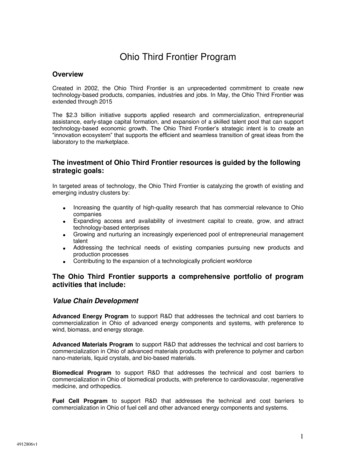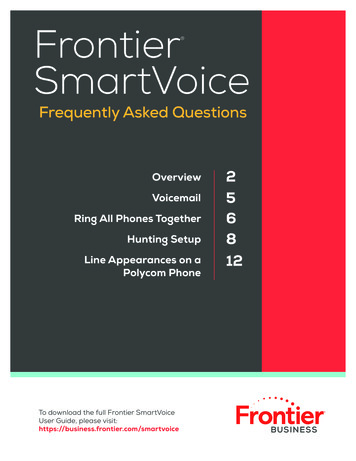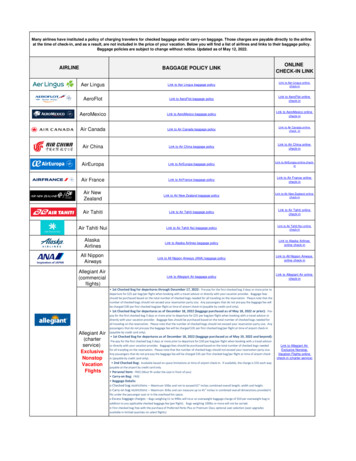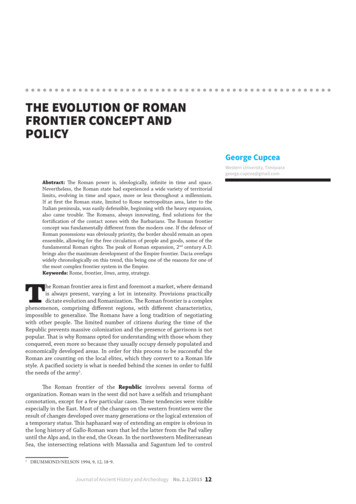
Transcription
A New Frontier in Business Intelligence:BI Applications for Outside AudiencesChallenges, solutions, and the growing potential of developing effective external BI apps
TABLE OF CONTENTSINTRODUCTION A Game Changer in Business Intelligence: External-Facing BI Apps 3WRITTEN BY:Amar Bhose, Program Lead, InfoCeptsShantanu Dixit, Data Visualization Practice Lead, InfoCeptsSarang Masne, SDK ConsultantVaibhav Fating, Senior BI ConsultantCONCEPT 1 Streamline the Navigation for Broad Audiences6CONCEPT 2 Ease the User Burden with Custom Prompts9CONCEPT 3 Fine-Tune the Layout, Prioritize Information12CONCEPT 4 Ramp Up the Interactive Features15CONCEPT 5 Develop Visualizations Based on Core Design Elements18CONCEPT 6 Integrate Time-Saving Notifications and Alerts22CONCEPT 7 Give Users Better Export Features26CONCEPT 8 Implement Proper Security Measures30CONCEPT 9 Optimize Performance to Meet the Standards of Today’s Users34CONCEPT 10 Prepare Your App for a Global Audience: Internationalization (i18n)37CONCLUSION Key Takeaways in External-Facing BI Application Development40
INTRODUCTIONA Game Changer in Business Intelligence:External-Facing BI AppsBusiness intelligence (BI) dashboards and apps have, for years, helped companiesutilize data to make better decisions. It’s only recently, however, that BI applicationshave moved beyond an internal-facing audience to help customers and businesspartners access and apply data in meaningful ways.
INTRODUCTIONA Game-Changer in Business Intelligence: External-Facing BI ApplicationsA Natural ProgressionEvolving BusinessIntelligenceGiven the relatively new and evolving focus onexternal audiences in BI, developers and companiesalike are scrambling to figure out how to create andimplement these apps for maximum user adoption.In many ways, external-facing BI app development is likethe Wild West, where rules and laws are not yet written,and lines on maps not yet drawn.What’s driving the outward focus, and what opportunities doexternal-facing BI apps bring to companies and consumers alike?What challenges do developers face, and what solutions or“best practices” help? This white paper is an attempt to answerthese questions — and give companies and developers alikea better understanding of what goes into effective external BIapp development. Throughout this document, we explore corecomponents of the development phase and share challenges andsolutions for creating effective navigations, interactive features,prompting systems, layouts and visualizations, security, and otherelements that can make or break the success of your BI app.Over the past few decades, business intelligence (BI) has evolved fromfinance-oriented BI dashboards to applications used by companies and teamsin countless industries — all for internal purposes. As the amount of datagenerated continues to grow, and as technology evolves, opportunities now existto make the data accessible and useful for external audiences like customers,partners, and suppliers. Many people refer to this as the “democratization ofdata,” and it’s happening now as products like the Fitbit enter the market andallow individuals to track health-related data; as Netflix and Amazon makepersonalized recommendations to customers based on browsing and purchasehistories; as retailers like PetSmart and Staples collect consumer behavior andpreferences that can be reported back to manufacturers and distributors asactionable data; and as Facebook and Twitter sell information to third-partycompanies and partners.“Externalizing BI will increasingly be an expectedpart of most customer and partner relationships.If I am a customer or partner of your organization,it is expected that your organization will provideme with certain information about my interactionswith your firm.” — Kurt Schlegel, “New Business Value: Turning BIfrom a Cost Center into a Revenue Generator,”Gartner Business Intelligence Summit 2010Before we get into the development aspects, however, let usfirst explain the difference between conventional and externalBI apps, how and why BI has evolved to this point, and thepotential this new kind of BI brings to companies.infocepts.comA New Frontier in Business Intelligence: BI Applications for Outside Audiences 2015 InfoCepts. All Rights Reserved.4
INTRODUCTIONA Game-Changer in Business Intelligence: External-Facing BI ApplicationsThis new mix of variables calls for a totally different user experience design tied closely to human factors.It also requires tighter security, a higher level of interactive features and visualizations, and the necessarypiloting that comes with the rollout of any technology-based product.Broader User Base, New ChallengesThis new kind of BI differs in many ways from more conventional BI. When wedevelop a conventional BI app or dashboard for a company, we’re creating asolution for an internal team with specific needs and skill sets. We can design theapp to meet those specifications — and train the team to use the app effectively.External-facing BI apps, on the other hand, have much broader target audiences,and it’s impossible to know what level of technology and analytical skills theusers will bring to the interactive experience. Since we don’t have access to theaudience and can’t train them, we have to develop a user experience that issmooth and unintimidating.Users of internal BI apps tend to understand BI tools, but we can’t make thatsame assumption with the users of external-facing apps. With the rise of mobileand web-based apps and portals, the majority of external users are accustomedto highly interactive experiences, fast performance, and one-click actions.Developers need to meet these expectations to make BI apps for externalaudiences successful.infocepts.comMore About Product DevelopmentAt their core, external-facing BI apps do what apps for internal audiences do:help users gather and make sense of data, and use that data to make decisions,gain insights, or take action. With external-facing apps, however, the app itself isa product sold by the company or offered as a value-added service, instead of asystem used by the company. The developer needs to approach it as such, whichrequires a shift in mindset: the app no longer serves internal audiences for thepurpose of improving how a company operates. In most cases, the app is aproduct for sale to a partner, supplier, customer, or even the general public.This new mix of variables calls for a totally different user experience designtied closely to human factors. It also requires tighter security, a higher level ofinteractive features and visualizations, and the necessary piloting that comeswith the rollout of any technology-based product.From a developer’s perspective, these tasks are a tall order. How can you achievethem? We explain in the pages to come.A New Frontier in Business Intelligence: BI Applications for Outside Audiences 2015 InfoCepts. All Rights Reserved.5
CONCEPT 1Streamline the Navigationfor Broad AudiencesToday’s users of BI applications, particularly those unaccustomed to BI reportsand dashboards, expect a convenient and self-explanatory navigation within theapp’s various modules and screens. Unfortunately, most out-of-the-box BI appscome with a generic navigation that fails to meet the needs of users (or a specificdomain) and is challenging to customize. Unable to find what they need, usersgrow frustrated and, too often, start avoiding the app.
WOULD YOU LIKE TO READ THE RESTOF THIS PIECE AND GET THE BACKSTORY OFTHE WORK THAT WENT INTO CREATING IT?Contact us for more information on thisand other great work from our clients.
TABLE OF CONTENTS INTRODUCTION A Game Changer in Business Intelligence: External-Facing BI Apps 3 CONCEPT 1 Streamline the Navigation for Broad Audiences 6 CONCEPT 2 Ease the User Burden with Custom Prompts 9 CONCEPT 3 Fine-Tune the Layout, Prioritize Information 12 CONCEPT 4 Ramp Up the Interactive Features 15 CONCEPT 5 Develop Visualizations Based on Core Design Elements 18











